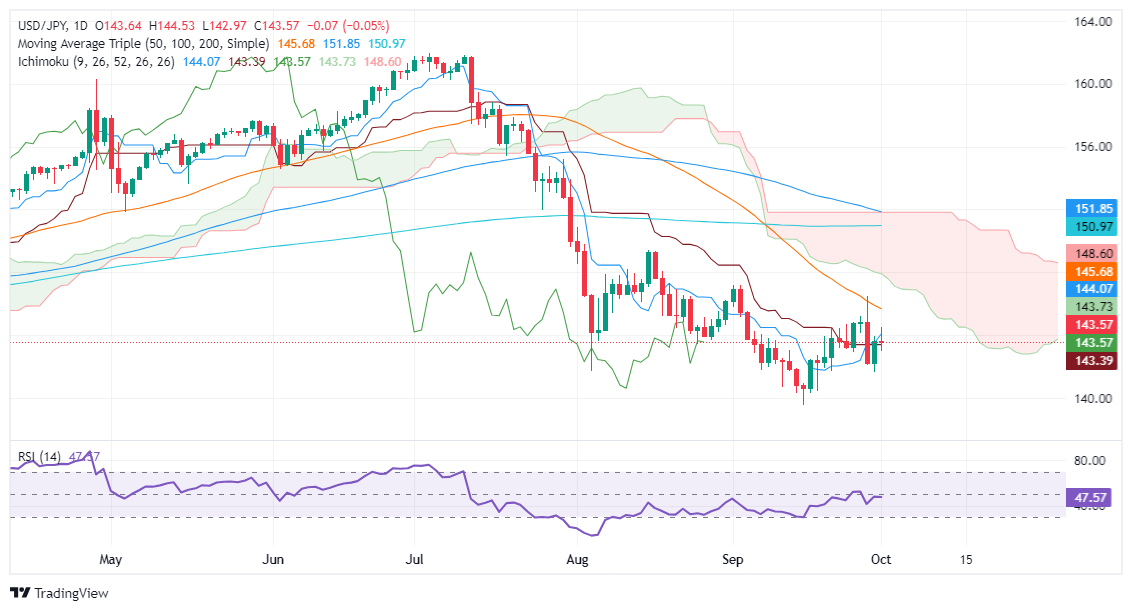USD/JPY Price Forecast: Forms doji consolidates at around 143.50
- USD/JPY closes unchanged at 143.58, forming a ‘doji’ candlestick, signaling indecision amid geopolitical risks.
- RSI suggests potential consolidation, with the pair expected to trade between 142.98 and 144.53 in the short term.
- A break above 144.53 could target 145.00 and the 50-DMA at 145.47, while a drop below 142.98 exposes the 141.65 support level.
On Tuesday, the USD/JPY formed a ‘doji’ and finished the day unchanged at around 143.58. During the session, the major seesawed at around a 150-pip range before ending the trading day with minimal gains of 0.02%.
USD/JPY Price Forecast: Technical outlook
The downtrend remains intact. Even though the pair was headed to sustain losses, the USD/JPY rallied on risk aversion amidst Iran's attack on Israel. That sponsored a leg-up toward the current exchange rate.
The Relative Strength Index (RSI) favors further downside, though its slope is flat. This hints at consolidation ahead. That said, the USD/JPY might trade within the 142.98-144.53 area in the near term.
If buyers clear the top of the range, that will expose the 145.00, followed by the 50-day moving average (DMA) at 145.47. A breach of the latter will expose the bottom of the Kumo at around 147.80-148.00.
Conversely, if USD/JPY tumbles below 142.98, the September 30 cycle low at 141.65 will be exposed. On further weakness, the next stop would be the September 16 pivot low at 139.58.
USD/JPY Price Action – Daily Chart

Japanese Yen FAQs
The Japanese Yen (JPY) is one of the world’s most traded currencies. Its value is broadly determined by the performance of the Japanese economy, but more specifically by the Bank of Japan’s policy, the differential between Japanese and US bond yields, or risk sentiment among traders, among other factors.
One of the Bank of Japan’s mandates is currency control, so its moves are key for the Yen. The BoJ has directly intervened in currency markets sometimes, generally to lower the value of the Yen, although it refrains from doing it often due to political concerns of its main trading partners. The BoJ ultra-loose monetary policy between 2013 and 2024 caused the Yen to depreciate against its main currency peers due to an increasing policy divergence between the Bank of Japan and other main central banks. More recently, the gradually unwinding of this ultra-loose policy has given some support to the Yen.
Over the last decade, the BoJ’s stance of sticking to ultra-loose monetary policy has led to a widening policy divergence with other central banks, particularly with the US Federal Reserve. This supported a widening of the differential between the 10-year US and Japanese bonds, which favored the US Dollar against the Japanese Yen. The BoJ decision in 2024 to gradually abandon the ultra-loose policy, coupled with interest-rate cuts in other major central banks, is narrowing this differential.
The Japanese Yen is often seen as a safe-haven investment. This means that in times of market stress, investors are more likely to put their money in the Japanese currency due to its supposed reliability and stability. Turbulent times are likely to strengthen the Yen’s value against other currencies seen as more risky to invest in.

